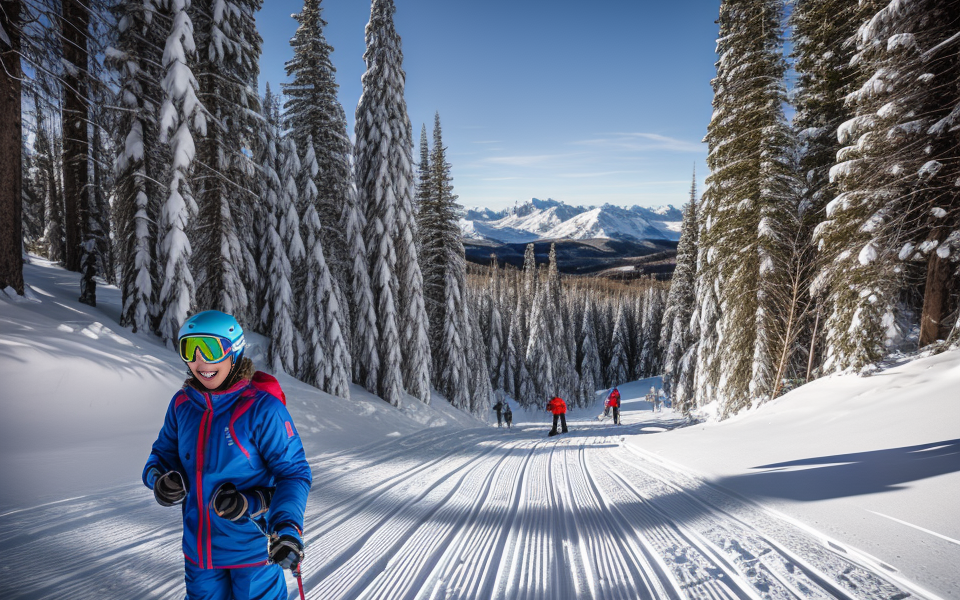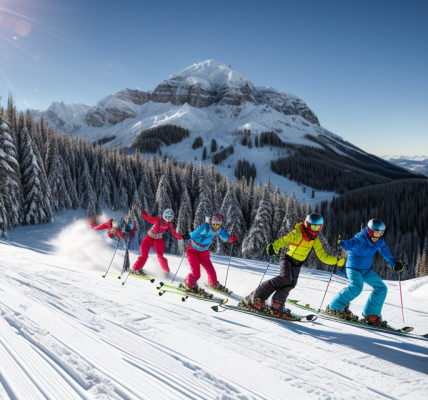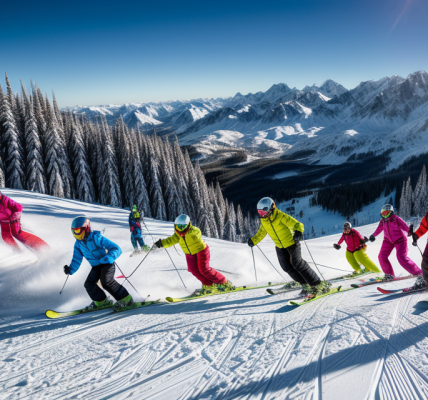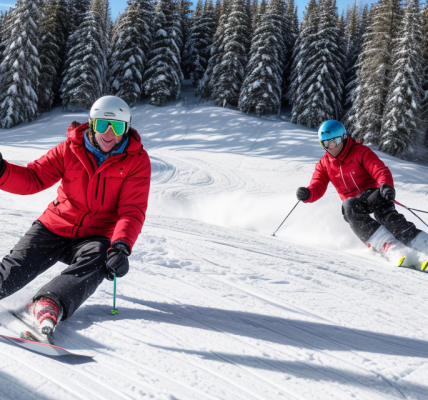Are you eager to hit the slopes but unsure where to start? Learning to ski can be a thrilling and rewarding experience, but it requires proper preparation to ensure a safe and enjoyable time on the mountain. Whether you’re a complete beginner or looking to brush up on your skills, this guide will provide you with all the information you need to get started. From selecting the right equipment to warming up your muscles, we’ll cover everything you need to know to make your first ski trip a success. So, buckle up and get ready to hit the slopes with confidence!
Essential Equipment for Skiing
Ski Clothing
When it comes to skiing, proper clothing is essential to ensure comfort and performance. Layering is the key to dressing for skiing, as it allows you to adjust your clothing to changing weather conditions throughout the day.
Layering for Optimal Comfort and Performance
The three layers of clothing that you should consider when skiing are the base layer, mid-layer, and outer layer. The base layer should be made of moisture-wicking material to keep you dry and comfortable. The mid-layer should be insulating, and the outer layer should be waterproof and breathable.
It is important to layer your clothing so that you can easily add or remove layers as needed. This will help you to regulate your body temperature and stay comfortable throughout the day.
Choosing the Right Base Layers, Mid-layers, and Outer Layers
The base layer is the layer of clothing that comes in contact with your skin. It should be made of moisture-wicking material to draw sweat away from your body and keep you dry. The mid-layer should be insulating, and the outer layer should be waterproof and breathable.
When choosing your base layer, look for a material that is soft and comfortable against your skin. Cotton is not a good choice for a base layer as it does not wick moisture away from your body. Instead, opt for materials like synthetic fabrics or merino wool.
The mid-layer should be insulating, and the outer layer should be waterproof and breathable. Choose a mid-layer that is made of a warm and insulating material like fleece or down. The outer layer should be waterproof and breathable to keep you dry and comfortable.
Wearing Appropriate Accessories: Hats, Gloves, and Goggles
In addition to your clothing, it is important to wear appropriate accessories to keep you comfortable and protected while skiing. A hat is essential to keep your head and ears warm, while gloves will keep your hands warm and protected. Goggles are also important to protect your eyes from the sun and wind.
When choosing your accessories, look for materials that are warm and breathable. A good hat should be made of a material that can wick moisture away from your head, while your gloves should be made of a material that is warm and flexible. Goggles should be designed to protect your eyes from the sun and wind, while still allowing you to see clearly.
Overall, proper clothing and accessories are essential to ensure a comfortable and enjoyable skiing experience. By layering your clothing and choosing the right materials, you can stay warm and dry, while still being able to move freely and comfortably on the slopes.
Skis, Poles, and Bindings
When it comes to skiing, having the right equipment is crucial to ensure a safe and enjoyable experience on the slopes. Here are some essential pieces of equipment that every beginner skier should have:
Selecting the Right Skis for Your Ability and Terrain
One of the most important decisions you’ll make when purchasing ski equipment is selecting the right skis for your ability and terrain. Skis come in a variety of shapes, sizes, and materials, each designed for a specific type of skiing.
For beginners, it’s recommended to start with all-mountain skis that are versatile and can handle a variety of terrains. These skis are typically wider and more forgiving, making them easier to control for those who are still learning.
It’s also important to consider the length of your skis. Generally, taller people will want longer skis, while shorter people will want shorter skis. This is because the length of the ski affects its stability and maneuverability.
Adjusting Poles to Suit Your Height and Skiing Style
Ski poles come in a variety of lengths and materials, and it’s important to choose the right ones for your height and skiing style. Generally, poles should be slightly taller than your height to provide proper support and balance.
Adjusting the length of your poles is important because it affects your posture and control on the slopes. If your poles are too short, you may feel unstable and have difficulty maintaining your balance. On the other hand, if your poles are too long, you may have difficulty controlling your movements and could hit your head on the ground.
Understanding Ski Bindings and Their Importance
Ski bindings are another essential piece of equipment that every skier should understand. Bindings are designed to release or lock down in the event of a fall, preventing the skier from sustaining serious injuries.
There are two main types of ski bindings: fixed bindings and adjustable bindings. Fixed bindings are designed for beginners and provide a simple, easy-to-use system that’s suitable for most skiers. Adjustable bindings, on the other hand, are more complex and provide more control over the ski’s behavior.
It’s important to choose the right binding for your ability and terrain. If you’re a beginner, it’s recommended to start with a fixed binding that provides a simple, reliable system for controlling your skis. As you progress and become more confident on the slopes, you can move on to adjustable bindings that provide more control and precision.
Skiing Fundamentals
Balance and Posture
Understanding the Body Position for Skiing
Before delving into the mechanics of balance and posture, it is essential to understand the basic body position for skiing. This position is often referred to as the “athletic stance,” which involves placing the weight on the balls of the feet while keeping the knees slightly bent. The chest should be up, and the shoulders should be back, creating an upright posture. This position allows for better balance, stability, and control while skiing.
Maintaining Proper Alignment and Balance
Maintaining proper alignment and balance is crucial for beginners, as it helps to prevent falls and improve control on the slopes. One of the most important aspects of balance is the distribution of weight. When skiing, the weight should be distributed evenly on both feet, with slightly more weight on the downhill ski. This allows for better control and stability, especially during turns.
In addition to weight distribution, maintaining proper alignment is also essential. The skis should be parallel to each other, with the downhill ski slightly in front of the uphill ski. This alignment helps to keep the body in balance and makes it easier to initiate turns.
Using the Poles for Support and Stability
Using the poles for support and stability is another essential aspect of balance and posture in skiing. Poles are not only used for propulsion but also for balance and control. When turning, the pole on the uphill side should be used for support, while the downhill pole should be held in the air. This helps to maintain balance and prevent falls.
Furthermore, poles can be used to help initiate turns. By planting the uphill pole in the snow, it can be used to generate leverage and initiate a turn. This technique, known as the “pole plant,” is essential for beginners and should be practiced regularly.
Overall, maintaining proper balance and posture is essential for beginners learning how to ski. By understanding the body position, distributing weight correctly, and using the poles for support and stability, beginners can improve their control and prevent falls on the slopes.
Turning and Stopping
Mastering the art of turning and stopping is crucial for any skier, as it enables them to control their speed and direction on the slopes. In this section, we will delve into the basic turns and techniques used in skiing to help beginners develop controlled and efficient turns, as well as master the art of stopping.
Learning the Basic Turns: Swiss, French, and Stem
There are three basic turns that every skier should learn: the Swiss turn, the French turn, and the stem turn.
The Swiss turn is the most fundamental turn in skiing, and it involves making a series of short, quick turns to change direction. This turn is commonly used at slow speeds and is the building block for more advanced turns.
The French turn is a more dynamic turn that involves longer arcs and is used at higher speeds. It is called the French turn because it was developed by the French ski team and is commonly used in the Alpine region.
The stem turn is a versatile turn that can be used in a variety of skiing conditions. It involves making a long, sweeping turn with the skis pointing in the opposite direction of the turn. This turn is commonly used when skiing through tight spaces or when changing direction quickly.
Developing Controlled and Efficient Turns
Developing controlled and efficient turns requires practice and patience. Skiers should focus on maintaining a consistent stance and using their legs and upper body to control their movements.
One key aspect of developing controlled turns is to maintain a neutral balance, which means keeping the skis parallel to each other and in line with the direction of travel. This helps skiers maintain control and avoid losing balance.
Another important aspect of developing efficient turns is to use the proper edge angle. Skiers should lean into the turn, allowing the ski edges to bite into the snow and provide support and control.
Mastering the Art of Stopping: Snowplough and Self-Arrest Techniques
Stopping is an essential skill for any skier, and there are two primary techniques used to do so: the snowplough stop and the self-arrest technique.
The snowplough stop involves spreading the skis apart and pointing them in opposite directions to create a V-shape. This allows skiers to slow down and come to a controlled stop.
The self-arrest technique is used when a skier needs to come to a sudden stop, such as when encountering a hidden obstacle or unexpected change in terrain. It involves digging the ski poles into the snow and using them to slow down and stop.
Mastering these basic turns and stopping techniques takes time and practice, but with patience and dedication, any beginner can develop the skills needed to ski with confidence and control.
Gradual Progression and Practice
When it comes to learning how to ski, it’s important to take a gradual approach and practice consistently. Here are some tips for beginners to follow:
Starting with Easy Terrain and Building Confidence
Beginners should start by practicing on gentle slopes with little to no obstacles. This will allow them to get a feel for the skis and build confidence before moving on to more challenging terrain. It’s important to remember that everyone learns at their own pace, so don’t feel pressured to move too quickly.
Gradually Progressing to More Challenging Slopes
Once you have gained some confidence and basic skiing skills, you can gradually progress to more challenging slopes. Start with slopes that are slightly steeper than what you are comfortable with, and take it from there. Remember to always ski within your ability level and never push yourself too hard.
Repetition and Consistency for Skill Development
Repetition and consistency are key when it comes to developing skiing skills. Practice the same techniques over and over again until they become second nature. It’s also important to ski regularly to maintain your skills and prevent rust from setting in.
In summary, beginners should start with easy terrain, gradually progress to more challenging slopes, and practice consistently to develop their skiing skills. By following these tips, you’ll be well on your way to becoming a proficient skier in no time.
Skiing Safety
Awareness and Respect
Skiing is a thrilling and exhilarating sport that can be enjoyed by people of all ages. However, it is important to remember that skiing also comes with risks and hazards. As a beginner, it is crucial to develop awareness and respect for the sport to ensure a safe and enjoyable experience. Here are some tips to help you achieve that:
- Understanding the Risks and Hazards of Skiing
- As a beginner, it is important to understand that skiing involves risks and hazards. Some of the most common risks include collisions with other skiers or snowboarders, falling, and hitting obstacles such as trees or rocks. It is essential to familiarize yourself with these risks to take necessary precautions and avoid accidents.
- Being Mindful of Other Skiers and Snowboarders
- Skiing is a recreational activity that involves many people. It is important to be mindful of other skiers and snowboarders on the slopes. You should always maintain a safe distance from other skiers and avoid crowded areas. Additionally, you should be aware of your surroundings and keep an eye out for other skiers who may be coming from behind or above you.
- Adapting to Changing Weather and Snow Conditions
- Weather and snow conditions can change rapidly, and it is important to be prepared for these changes. Before you hit the slopes, check the weather forecast and be aware of any changes in temperature, wind, or snowfall. Additionally, pay attention to the snow conditions and adjust your skiing style accordingly. If the snow is hard and icy, you may need to ski more cautiously to avoid slipping and falling. On the other hand, if the snow is soft and powdery, you may need to adjust your speed and ski more slowly to avoid getting stuck in the snow.
Emergency Procedures and First Aid
When skiing, it is important to be prepared for any potential accidents or injuries that may occur. Knowing what to do in case of an emergency can help you to act quickly and effectively in a situation where every second counts. Here are some tips for handling emergencies on the slopes:
Knowing What to Do in Case of an Accident or Injury
In the event of an accident or injury, it is important to stay calm and assess the situation. If someone is injured, the first step is to call for help immediately. If you are unable to call for help, try to flag down a ski patroller or other trained professional who can assist you.
If the injured person is unconscious, do not move them unless they are in immediate danger. If they are in danger, move them as little as possible to get them out of harm’s way. If they are not in danger, do not move them at all, as doing so can cause further injury.
Basic First Aid Techniques for Common Skiing Injuries
In addition to knowing what to do in case of an emergency, it is also important to have basic first aid skills to treat common skiing injuries. Some common injuries that you may encounter on the slopes include:
- Sprains and strains: These injuries are typically caused by overuse or repetitive motions, and can be treated with rest, ice, compression, and elevation (RICE).
- Fractures: If you suspect that someone has a fracture, do not move them unless they are in immediate danger. Instead, immobilize the affected area and call for help.
- Cuts and abrasions: These injuries can be treated with cleaning, bandaging, and applying antibiotic ointment to prevent infection.
Seeking Medical Assistance When Necessary
In some cases, it may be necessary to seek medical assistance for an injury. If someone is unconscious, has severe bleeding, or is in significant pain, it is important to call for medical help immediately.
If you are unable to call for help, try to flag down a ski patroller or other trained professional who can assist you. If you are able to call for help, provide as much information as possible about the injury and the location of the victim.
By knowing what to do in case of an emergency and having basic first aid skills, you can help to keep yourself and others safe while skiing.
Mountain Responsibility and Ethics
As a skier or snowboarder, it is essential to understand and adhere to the responsibility code, which is a set of guidelines designed to promote safety and responsible behavior on the mountain. The code includes the following key points:
- Adhering to the Responsibility Code: This code is a set of guidelines that outline the responsibilities of skiers and snowboarders to themselves, other skiers, and the mountain. The code includes guidelines on speed, trail usage, and avoiding collisions. It is important to understand and follow the code to ensure the safety of all skiers and snowboarders on the mountain.
- Following Trail Markings and Closing Boundaries: Ski resorts typically mark trails according to their difficulty level, and it is important to follow these markings to ensure that you are on a trail that is appropriate for your skill level. Additionally, it is important to respect closing boundaries, which are in place to protect skiers from hazards such as closed trails or areas undergoing maintenance.
- Properly Using Lifts and Avoiding Crowded Areas: Ski lifts are an essential part of the skiing experience, but it is important to use them properly to avoid accidents. This includes standing in the correct loading position, keeping your arms and legs inside the lift, and avoiding jumping or diving off the lift. Additionally, it is important to avoid crowded areas, as this can increase the risk of collisions and accidents.
By following these guidelines, skiers and snowboarders can help to ensure a safe and enjoyable experience for everyone on the mountain.
FAQs
1. What equipment do I need to go skiing?
You will need a pair of skis or a snowboard, ski boots, and poles. You can rent this equipment from a ski shop or buy it new or used. It’s important to make sure that the equipment fits you properly and is in good condition before you hit the slopes.
2. What should I wear when skiing?
You should wear warm, comfortable clothing that allows you to move freely. This includes a base layer, mid-layer, and outer layer. You should also wear a helmet to protect your head and goggles to protect your eyes from the wind and snow.
3. How do I get to the ski resort?
There are several ways to get to a ski resort, including driving, taking a bus or train, or flying. You should plan your transportation in advance and make sure you have everything you need for the journey, such as a valid ID and a credit card.
4. What should I do before going skiing?
Before you go skiing, you should stretch and warm up your muscles to prevent injury. You should also take a lesson to learn the basics of skiing and get familiar with the equipment. It’s also a good idea to eat a light meal before hitting the slopes and stay hydrated throughout the day.
5. What should I do if I fall while skiing?
If you fall while skiing, you should try to land on your back or on your side to avoid injury. You should also try to relax and stay calm, and avoid moving until you are sure that you are not injured. If you are injured, you should seek medical attention immediately.
6. What should I do if I get lost on the slopes?
If you get lost on the slopes, you should stay calm and try to find a lift or a ski patroller to help you get back to the base. You should also try to stay in one place and wait for help to arrive. It’s a good idea to bring a map or a compass with you to help you navigate the slopes.




